Skin Problems?

Is your skin itchy, oozing, or breaking out? Moles, psoriasis, hives, eczema, and recently associated Covid-19 coronavirus rashes are just a few of the more than 3,000 skin disorders known to dermatology. Changes in color or texture can result from inflammation, infection, or allergic reactions anywhere on the body. Some skin conditions can be minor, temporary, and easily treated -- while others can be very serious, and even life-threatening. Read on to see signs and symptoms of the most common skin disorders and learn how to identify them.
Covid-19 (Coronavirus) Skin Rashes
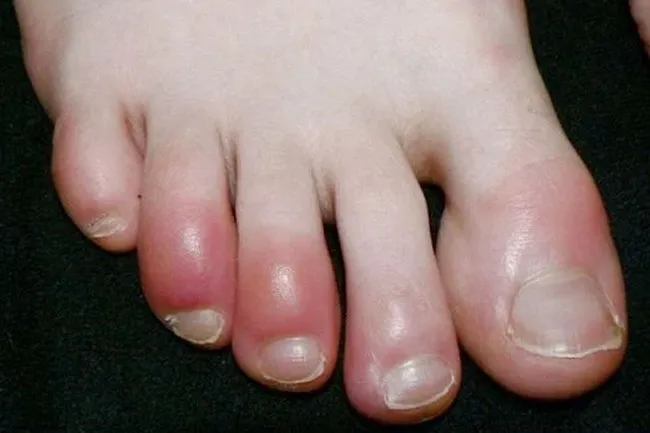
Skin rashes have been associated with COVID-19 infection. Much like other viral diseases such as HIV and bacterial diseases like syphilis, COVID-19 rashes can take many different forms. One study from Spain identified five patterns of COVID-19 rash. The most common type was a "macropapular rash." These rashes feature both small, flat discolorations ("macules") and small, elevated lesions ("papule"). These rashes are associated with more severe COVID-19 infection, as 2% of those who got them in the Spain study reportedly died from the illness. Other rashes associated with COVID-19 include thickened lesions developing on the heels of the feet, lesions that resemble chickenpox, and rashes that resemble those seen with dengue fever.
Some dermatologists have reported cases of so-called "COVID toe" in both adults and children. These lesions may be reddish, elevated lesions that flatten after about a week. Some of the patients found their COVID toe rashes itchy, and others did not. Some found it painful when their toes were pressed, and others did not. More research is needed, as some of the rashes reported in COVID-19 patients resemble drug reactions. For safety reasons, researchers have been unable to determine if drug interactions are responsible in these cases, or whether the novel coronavirus itself causes these rashes.
Shingles (Herpes Zoster)

Shingles, also known as herpes zoster, is a skin disease caused by the return of a chickenpox infection from latently infected nerve cells in the spinal cord or brain. It begins as a painful sensation which is often mistaken for a musculoskeletal injury or even a heart attack. It is soon followed within one or two days by a red, blistering unilateral (one-sided) rash distributed to the skin supplied by a sensory nerve (a dermatome). Zoster tends to occur most often in the elderly and can be largely prevented or made less severe with a vaccination. Treatment with antiviral drugs within 48 hours of the onset of the eruption may limit the development of a persistent, severe pain (neuralgia) at the site of the eruption.
Hives (Urticaria)
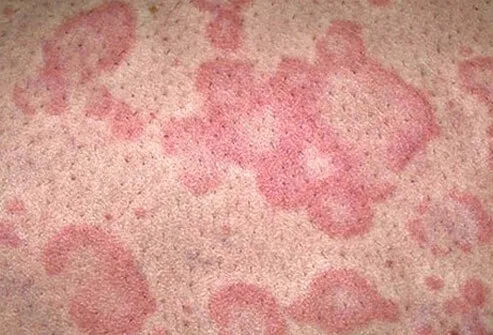
Hives, also known as urticaria, is one of the most common allergic skin conditions. It most often occurs due to antibodies in the bloodstream that recognize foreign substances. This eruption appears suddenly anywhere on the body as elevated blanched bumps surrounded by an intensely itchy red rash. There may be many lesions, but each one only exists for eight to 12 hours. As older ones resolve, newer ones may develop. Most of the time, urticaria resolves spontaneously within eight weeks and is treated with oral antihistamines for symptomatic relief.
Psoriasis
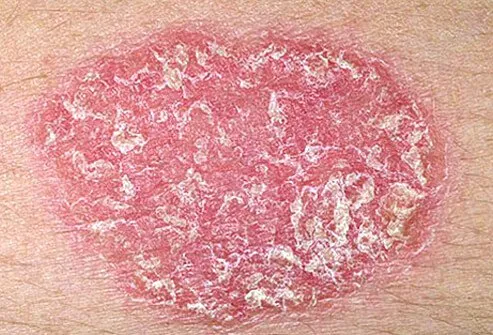
Psoriasis is a chronic, inflammatory genetic condition in which patients develop scaly red bumps that coalesce into plaques. Symptoms of psoriasis typically occur but are not limited to the scalp, elbows, and knees.
Psoriasis is not curable; flare-ups come and go by themselves. There are a variety of treatments depending on the severity and extent of involvement, which vary from topical creams and ultraviolet light exposure to oral drugs and injectable medications. Patients with psoriasis more commonly develop cardiovascular disease and diabetes, which may be attributable to system-wide inflammation.
Eczema (Dermatitis)
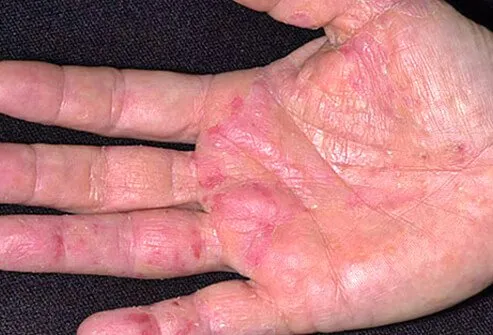
Eczema (sometimes called "dermatitis") is a genetic condition associated with itchy, dry skin. It usually develops in early childhood with symptoms of a chronically itchy, weeping, oozing sores. Eczema tends to be found on arm creases opposite the elbow and on leg creases opposite the knee.
Many eczema patients also have inhalant allergies such as asthma and hay fever. Eczema improves with age. Treatment involves applying emollients to wet skin and using topical steroids.
Types of Eczema
There are many types of eczema, and many types include the word "dermatitis" (in dermatology, dermatitis is another word for eczema). For instance, eczema types include stasis dermatitis and dyshidrotic eczema. A dermatologist can help you understand what type you have. Two of the most common types are:
- Atopic dermatitis
- Contact dermatitis
Rosacea

Rosacea is a chronic inflammatory condition of the face that is characterized by redness, dilated blood vessels, papules, pustules, and occasionally by the overgrowth of nasal connective tissue (rhinophyma). It superficially resembles teenaged acne, but it occurs in adults. Persistent facial flushing is an early sign of the skin's uncontrolled sensitivity to certain naturally produced inflammatory chemicals. Treatment of rosacea involves topical and oral drugs.
Cold Sores (Fever Blisters)
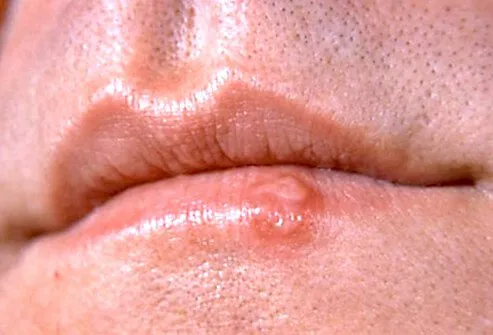
Herpes labialis (cold sore) is caused by the herpes simplex virus. Cold sores commonly appear on the edge of the lip. This virus exists in a dormant state in the spinal cord nerve cells, and after certain environmental triggers like a sunburn or a cold, the virus is induced to travel along a peripheral nerve to the same skin site over and over again. The eruption is self-limited to about seven to 10 days so that treatment is unnecessary unless the eruption becomes too frequent.
Plant Rashes

In allergic individuals, the development of a linear blistering eruption occurs within 24-48 hours of exposure to a member of the poison ivy or poison oak family of plants. Since the plant contains highly allergenic chemicals, most people will become allergic after a single priming exposure. The eruption will resolve within three weeks but will occur again the next time the skin comes in contact with the plant.
Treating Plant Rashes

The repeated application of cool wet compresses to the blisters followed by evaporation of the water can be soothing and speed healing. Treatment with steroids creams or even oral steroids may be required in severe cases. Once a person is allergic, this is permanent; it is important to avoid this plant family assiduously so this very unpleasant allergic reaction will not recur. Many of those allergic to poison ivy or poison oak (Toxicodendron) are also sensitive to mango skin and cashew nut oil.
Razor Bumps
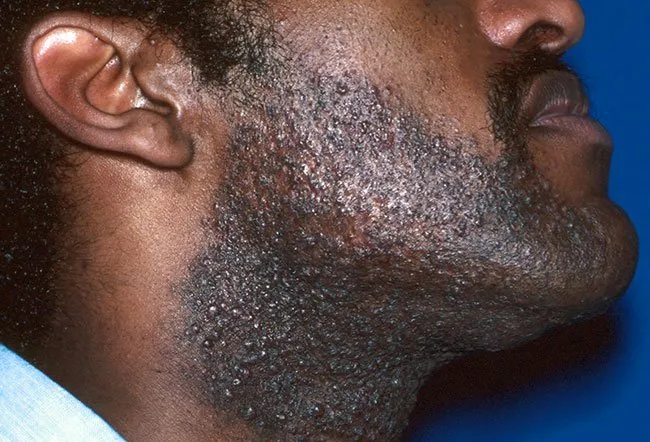
This eruption occurs in areas of the skin in which hairs have been recently cut or extracted. This is commonly present in the beard area of individuals with very tightly coiled hair. When the hair is cut off or plucked out below the level of the follicular pore, it tends to curl into the side of the follicle and cause an inflammatory bump. Not shaving closely is very important in preventing this skin condition.
Skin Tags

Skin tags are small, fleshy, fibrovascular, pedunculated (on a stalk) growths that are often are found on the neck and armpits. They are generally asymptomatic unless they become irritated by frictional forces or their blood supply becomes compromised. They are very common and need not be removed or destroyed unless they become irritated.
Acne
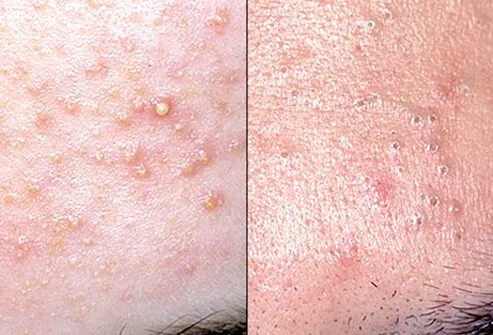
Acne vulgaris is usually a noninfectious eruption of papules and pustules (pus-filled blisters) on the face and occasionally on the chest and back. Acne occurs in all teenagers as they progress through puberty. Symptoms like comedones (blackheads) and inflammatory papules and pustules all appear simultaneously.
Despite rumors to the contrary, acne is not caused by dirty skin. Instead, it is mediated by hormones that begin to circulate during puberty and excess sebum or oil production. The condition generally resolves around the age of 20-30 but may produce scarring if severe and left untreated.
Athlete's Foot

One of the most commonplace skin conditions is athlete's foot. And one of the most common causes of athlete's foot is an infection of the dead superficial layer of the skin called the stratum corneum by a fungal mold (tinea pedis) called a dermatophyte.
If inflammatory, this condition may cause fluid-filled blisters that are quite itchy. Noninflammatory tinea pedis produces scaly, dry skin. Often it is only mildly irritating. Tinea pedis is probably frequently contracted by walking barefoot in locker rooms. Topical antifungal creams are available over the counter and can be helpful in treating this skin infection. More powerful medications can be prescribed by a dermatologist.
Moles
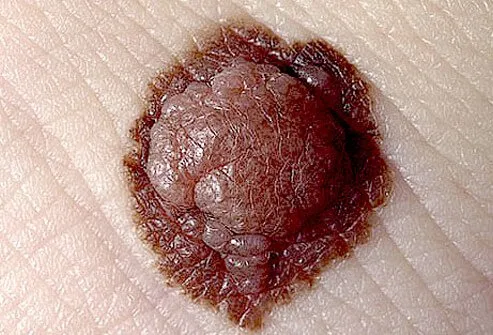
Although the term mole may cover a variety of different sorts of skin growths, most often it refers to a localized accumulation of pigment-producing cells called melanocytes. These are generally uniform in color and round in shape. In dermatology, moles are sometimes known as benign neoplasms.
Melanocytic nevi (moles) range in color from beige to black, they're about ½ an inch in diameter, and are often located on sun-exposed skin. Poorly pigmented individuals may have an average of 35 of these growths by the time they are 35 years old. These are benign lesions but can be confused with various pigmented skin cancers. Pigmented lesions that itch, bleed, or grow could be cause for concern.
Age or Liver Spots

Liver spots (also called age spots) are a common skin condition that typically appears on the face and forearms of older individuals. Although these flat brown spots cause no symptoms, patients detest them because of their unsightly appearance. They can be treated in a variety of ways, but treatment is not medically necessary.
Pityriasis Rosea

This rash usually begins in a young adult as a single scay bump or patch and then extends to cover much of the torso with many scaly spots that are elliptical in shape. They are associated with modest itching which only occasionally requires treatment. The condition usually lasts about 6-8 weeks in total.
Melasma
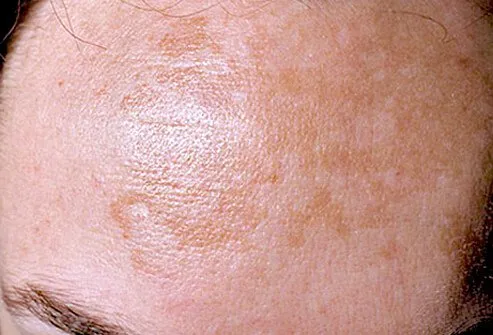
Melasma is another commonly experienced skin condition. The main symptoms are brown patches of skin. These patches are typically found on your face.
This condition occurs most commonly in women of childbearing age and is often associated with pregnancy or the ingestion of oral contraceptive medication. This flat brownish pigmentation occurs on the forehead, cheeks, and in the mustache area of the upper lip. It often persists after pregnancy or after birth control has ceased. Sunlight will make it darker. Successful treatment is not easy, and strict sun protection is a necessity.
Warts

The development of small keratotic tumors of the skin is caused by one of about 200 members of the human papillomavirus group. They often spontaneously go away, but particularly stubborn warts may require medical intervention. The proliferation of various treatments reflects the fact that successful resolution mostly depends upon the patient's immune response. There are a variety of treatments available without a prescription that ought to be tried prior to seeing a physician.
Seborrheic Keratoses
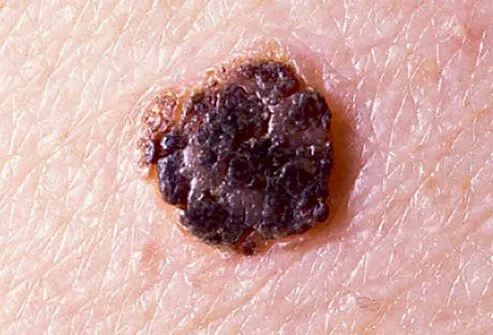
This is the single most common benign bump present on people as they age. (Benign means it does not indicate skin cancer). Lesions may be present anywhere on the body and generally do not produce symptoms. They appear as black, brown, or yellow bumpy lesions which give the appearance of having been "glued" onto the skin. They are of no medical significance aside from the fact that they are occasionally confused with pigmented skin cancers.
Seborrheic Dermatitis
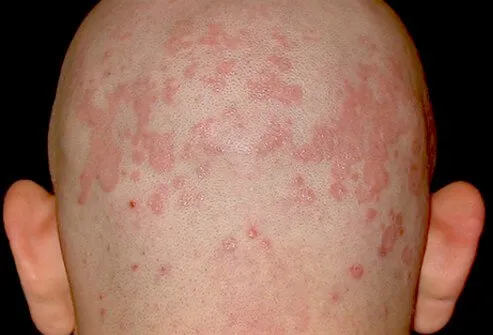
Seborrheic dermatitis is the single most common rash of adults. When it occurs in infancy, it is commonly called cradle cap. The adult disease tends to favor the scalp, skin behind the ears, forehead, brows, nasolabial folds of the face, mid-chest area, and the mid-back, producing an itchy, red scaling dermatitis. The scaling in the scalp can be conspicuous, producing impressive dandruff. The cause of this condition is unclear, but it responds well to topical steroids and to topical antifungal creams. Medicated shampoos containing tar, selenium sulfide, and zinc pyrithione are often effective. This condition commonly improves spontaneously but will ultimately recur. There is no cure so treatment must continue indefinitely.
Rosacea, Acne, Shingles, Covid-19 Rashes: Common Adult Skin Diseases
This tool does not provide medical advice. See additional information: 
© 1996-2024 WebMD, LLC. All rights reserved.
